Private homepage – Hans-Georg Michna
Kenya travel reports: 1999, 2000, 2002, 2003, 2004, 2005, 2006, 2007, 2008, 2009, 2010, 2011, 2012, 2013-Goma, 2013, 2014, 2015, 2016, 2017, 2018, 2019
Kenya Safari Travel Plan, Kenya 1980-2000 photos
Kenya 2004
A personal travel report from Kenya in June 2004
Last change 2005-05-13 Copyright 2004-2023 Hans-Georg Michna
Click on the small pictures to see them enlarged, usually to 800 x 600 pixels.
Times are given in local Kenyan time in 24h format (without "am" or "pm"), i.e. 0:00 to 23:59 o'clock.
If you cannot play DivX movie clips, install a matching codec. Download (or immediately open) and install a suitable codec filter pack, for example, this. You can then watch the DivX movies through the Windows Media Player or through the Media Player Classic (MPC) that's included with the codec pack.
Alternatively, if you don't want to install any codec, download and install (or just copy) the VideoLAN player (VLC) from www.videolan.org, then download the video by right-clicking the link or picture below and selecting the command Save target as ..., then open the AVI video file in the VLC player.
A few readers had the problem that after clicking on a picture, then going back to the main page, all thumbnail pictures were reloaded. This is typically caused by Internet Explorer cache corruption. It can often be repaired by going to the Internet options and deleting the temporary Internet files.
All photos are subject to copyright . If you want to reuse any photo, send me an email asking for permission, and I can send you the full-size photo, usually 1,600 x 1,200 pixels. Photos bear the copyright 2004-2023 Hans-Georg Michna.
[I still use and like my Panasonic Lumix DMC-FZ1-2 digital camera (see http://www.steves-digicams.com/2003_reviews/fz1.html for details, although my camera has meanwhile been upgraded to FZ2 level firmware). Most photographs in this travel report are reduced to 800 x 600 pixels and JPEG-compressed with medium strength to make them more palatable for the web.]
Ive slowly begun to pack my bags and to read (and edit) my own travelling checklist (in kenya.htm#Preparations and in the old German version kenia.htm#Reisevorbereitungen).
These checklists are something wonderful, because you cant forget anything important. Theyre a peace of mind thing. So far no stress.
The local flight times are Munich 07:00 08:10 London Heathrow 10:25 20:45 Nairobi.
I arrived at the Munich airport in time, which was a good idea because of some luggage problems. I tried to check in four pieces of luggage, way above the 23 kg limit, and talked to the very friendly check-in lady about my predicament. Two of the four pieces were gifts, not to be brought back. If she wouldnt let me take them, I would have had to leave them behind. Not too bad, but not nice for the people who should get the gifts, mostly clothes.
It turned out, however, that on the Nairobi line there are different rules. I had checked this on the BA web site, and it wasnt quite consistent, but I had come away with the conclusion that the 23 kg rule applies.
Not so, said the check-in lady. To Nairobi I can take two pieces of luggage. The weight limit is much higher, plenty enough for me. But I had four pieces.
So the lady went over to the bulk luggage people and asked them. They had a huge, sturdy, transparent plastic sack, marked Lufthansa, with a nice yellow carrying rope. So we stuffed three bags into that sack and thus turned them into one piece. A secure knot in the rope will make sure they stay one piece, or so I hope. Ill learn about that tonight when I arrive in Nairobi.
The flight was late taking off, then went north past Nuremberg, then gently arced to the left, crossed the River Rhine near Bonn and continued via Aachen through Belgium and the Netherlands, and finally across the British Channel past Stansted Airport to London.
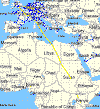
GPS track of most of the flight
Before London we had to wait again, so the plane flew several racetrack circles, allowing every passenger a nice view over the city of London. Then we continued and flew a very nice sightseeing arc around the docklands airport, the center of the city, the Tower Bridge, and on to Heathrow airport.
London had unusually fine weather, blue sky with few thin clouds, temperatures forecast to reach 29C. The pilot added, believe it or not, when he read the forecast.
Fortunately there was still enough time before my continuing flight to Nairobi. I could even pull the aerial photos from the camera and write this while the impressions were still fresh. No Internet caf though, so the uploading will have to wait until Nairobi tonight (if I can stay awake long enough).
While I write this paragraph, Im already flying the long distance. At this time Im flying somewhere above the Sudan, approaching Kenya. The sun is about to set over the desert.
The almost full Boeing 747 took much of the runway at Heathrow to lift off and climbed decidedly less spectacular than a typical twin engine plane. But once it reached its en-route height, the speed went up to almost 1,000 km/h due to a nice tail wind. Thus we have already made good a lot of what we lost due to a long waiting line for takeoff at Heathrow.
The Sahara desert is unbelievable as always. Only deep into Sudan I saw the first clouds again and some thin vegetation on the ground.
After sunset we landed in Nairobi. (Remember, the sun sets at about 18:30 oclock in Kenya and rises at 6:30.) The visa procedure took an inordinate amount of time, but the luggage unloading took even longer. Shahid Rasul had come as promised and brought me a jeep, a Suzuki Maruti Gypsy as planned. This is an Indian-built car, by license from Suzuki Japan. It is a tad more expensive than the Suzuki Sierra, but much nicer in several respects.
A nice surprise was the exchange rateI got almost KSh100 for the . The Kenya Shilling is more or less pegged to the dollar, and the has risen against the $, so it has also risen against the KSh. Practically everything in Kenya is now a lot cheaper than it used to be.
A busy day today, not worth describing in detail. The worst news are that the open Internet number I used last year no longer works, so I will not be able to update this page as often as I would like. Most likely Ill use a mobile phone for that next year, then it will be a good connection even out in the bush, or so I hope.
But some things get better and easier, such as obtaining cash or shopping.
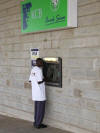
The ATM that just gave me 20,000 Kenya Shillings
The Uchumi supermarket photo led to questioning by the security personnel, but I could convince them that Im only a harmless tourist. They had to ask their manager though.
I did all the important things, collected my renewed pilot license, and drove to the Rasuls headquarters (www.rasuls.com) to let them roll my credit card for the jeep.
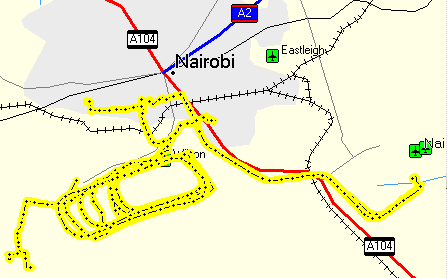
GPS track of 9. and 10. June. The racetrack pattern is the check flight.
Today I also wanted to collect money from an ATM (Automated Teller Machine), but the entire communications system of Barclays Bank had broken down, and apparently thats the only bank that can handle my Maestro (ec) card. This changes my plans, because I intended to forward some money to a young lady whose university studying is supported by some of my friends, then take her home, which would have been on my way anyway. Now Ive changed my itinerary and am currently planning to drive to Samburu tomorrow before sunrise. I wouldnt be surprised though if any minute a new text message arrives that changes my plans again. And anyway, my new path to Samburu happens to take me right past her place in the morning.
But at noon the ATMs were still not working. At 17 oclock I had a successful check flight with a Cessna 182.
When it was already dark, I drove to the big Uchumi supermarket again and checked the ATM. Successnow it worked! I withdrew more money and decided to change my plans accordingly. I also found out that the maximum offered by menu is KSh20,000, but when you select Other amount, you can enter up to KSh40,000. Good to know.
In the evening I sat in the Aero Club of East Africa (a private flying club, not open to the public), gave my vote for the Aero Clubs annual general meeting to Colin Davies who needs it for a good cause, and decided to go to bed early, but not before writing this.
These last two days have been interesting, but not relaxing. I was busy all the time. Now Im looking forward to leaving Nairobi and getting back to nature.
I drove north, passed by the Kenyatta University campus to meet the student and deliver the money from my friends to her. Then I drove on, this time via Muranga, on an old major road. It turned out that the road from the turnoff (from the extended Thika Road) to Muranga was new and in perfect shape. Past Muranga the road gets worse, but is still drivable at reasonable speed for upcountry Kenya. And the landscape is interesting.
Some 10 km before Nyeri the road again becomes excellent and remains so until nearly Isiolo with the exception of Nanyuki, around which the road is rather bad.
After Nanyuki the road climbs up to almost 2,500 m and crosses the nothern foot of Mt. Kenya. Near the high point there is a petrol station that advertises its clean toilets. I used them and also filled the tank. This is as good as filling in Isiolo, because one can actually drive from near that place to Isiolo without using fuel. You can roll from just beyond that petrol station to the boundary of Isiolo with the engine switched off. An ideal stretch for a soap box race.
I continued through Isiolo and then further north on the rough Isiolo Road, past the entrance to Samburu and almost up to Archers Post. There I found the road to Shaba, which branches off to the east. The only lodge (Shaba Sarova) is near the entrance, and I booked myself in for a night.
I even had some time left for a game drive through the nature reserve, but found that Shaba cannot compare with Samburu or Buffalo Springs in terms of wildlife. I did see one animal though that is very rare in Kenya, the klipspringer.


Joy Adamsons picnic site; klipspringer
The lodge is built around a major spring that also provides all their water. At night the whole garden around the spring glistens of thousands of glowworms.
After what I had seen, Shaba is not the best place for game viewing. Though it has a very beautiful scenery, which seems to draw film teams from all over the word to the place (currently a Chinese film team is there), wildlife seems to be sparse. So I decided quickly to leave Shaba for Samburu.
Already in the lodge, then again at the gate of the Shaba nature reserve, people asked me for a lift to Isiolo. I refused, because I didnt go there, but there was a Somali girl at the gate who wanted to go only to Achers Post. Sarah told me that she had tried to work for the Chinese film team, but one of the Kenyan managers apparently didnt like her, and so she lost the job.
[Later in July she wrote me an email saying, please give people my address so they can write me. So if you feel like it, send her an email. She is looking for a job as housemaid or baby sitter, while doing volunteer work in a HIV & AIDS project. If you happen to know a job for her, please let her know.]
She was a very likable and happy person, and she also spoke good English, so I enjoyed her company. We talked about various things, and when I told her that my mother is 83 years old, she immediately told me to tell her, God loves her. (83 is an age that is a bit more difficult to reach in developing countries.) She was also one of the few people who make it a point not to ask for money, although she certainly needs some.
She is an example of a victim of one of Africas senseless wars, in this case the recent war between Somalia and Ethiopia, in which Ethiopia had the better weapons and Somalia countered by sacrificing incredible numbers of people, one of them Sarahs father. She did not have the time to tell the whole story, but in short, her mother and she fled to Kenya, and so I got to meet her at the border between the controlled and the uncontrolled parts of Kenya, which describes Achers Post rather well. This also coincides with the border of normal tourism.
She may be another example for a person who got stuck on the rim of a developing country in spite of being gifted and talented and a person the world economy can actually not afford to lose. But the hurdles in front of a successful career are so high for her that she may never be able to get a job in which she can utilize her talents fully.
Sometimes I wish I had the means to tour developing countries and look for talented, but not appropriately employed people. In effect I would tell a country, if you cannot make use of this person, I will find another country that can. But of course I dont have the means, so I can only look on, be sad, and write it down here in the hope of making some more people understand.
The handicaps can be fundamental and difficult to overcome. The biggest handicap may be poor education. If you live at the outer edge of a developing country, good education may simply not be available.
From this brief encounter I cannot really judge anything, but it seems pretty obvious to me that she is very much in the wrong place in a desolate roadside town like Archers Post or even in the bigger nearby town of Isiolo. Moreover, being Somali, she is an outsider without the support of the major local tribes. In Kenya this still matters.
So I had to drop her in Archers Post and continue my way west towards Samburu. The nature reserve begins not very far from Archers Post and the Isiolo road, and soon I was alone again with nature and wild animals.


Vulture-headed Guinea fowl; kingfisher

Elephants crossing Samburu River
Video
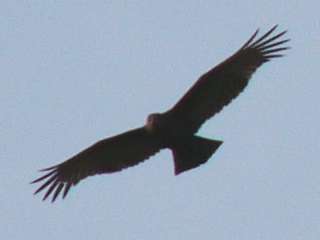
Bird of prey

Safari ants running in line
Video
When I was about to get dark, I continued to an old camp site that is rarely used these days, perhaps even unknown (waypoint -SAMB2CAMP in the map). The place is in the saddle between two hills and overlooks the area widely.
I prepared the jeep and tried a new mosquito net construction. I had brought two pieces of insect gauze, each big enough to cover half of a car door. I wrapped a piece around the car door from the outside, pulled from the inside and shut the door. It is easy to do and turned out to be perfectly effective. The door lock punches a hole in the gauze, but that only means that you have to put it roughly in the same place the next time you use it.
I had thus a flow of fresh air inside the car, but no mosquitos and no other critters.
Temperature is a problem. In the evening it is still quite warm for several hours, until the air cools down significantly. I found that the only way to handle this is to sleep uncovered through the first part of the night, until you wake up because it gets too cold. Then you creep inside the sleeping bag and sleep on.

GPS track, game drive in Samburu
In the morning I woke up, repacked the jeep and drove off to an early morning game drive.

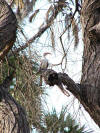

Grey heron; hornbill; dikdik, one of the smallest gazelles
When I was already on my way to the lodge, slowly meandering along the river, I suddenly noticed my first flat tire. I changed wheels (still can do that in less than 10 minutes) and drove on to the lodge to have it repaired.
I also checked into Samburu Lodge and got a nice room for a reasonable low season price, even though it included the full board. I took a shower, a lunch, a little rest, then I drove off for an evening game drive that was dominated by elephants.


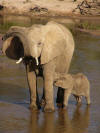
The now almost dry Samburu River; secretary bird; baby elephant suckling
Elephants can drink with the help of their trunk, so they dont have to kneel down. But they cannot actually suck water in through their nose directly. Instead they fill their trunk with a few liters of water, then squirt them into their mouth.
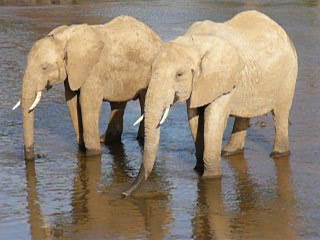
How elephants drink
Video
Baby elephants cannot do this instinctively, they have to learn it first. In the following video clip you can see three different kinds of drinking. One baby elephant suckles milk from his mother, another tries to drink like the adults, but then it doesnt work, either because he hasnt actually sucked water into his trunk or because he deems the procedure too slow, and so he kneels down, drinking water through his mouth.
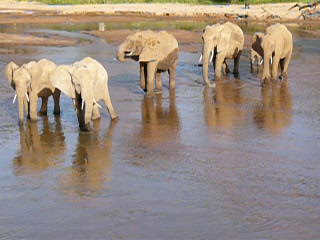
Elephants crossing Samburu River
Video


Elephants in Samburu River; two Impala bucks

The tire killer thorns of Acacia tortillis
In the evening I had the second flat tire in one day. Unfortunately the tire went flat exactly at a place where a whole group of elephants was walking towards me. I trusted them, and they went out of their way to avoid conflict. I believe they noticed that my situation was unusual. I walked around the car, had to make funny noises like clapping door, clapping hood, etc. They may have noticed that my situation was unusual.
It turned out that the culprit was not an acacia thorn this time, but a nail that had survived an earlier repair and was now sticking out of the inside surface of the tire by about 3 mm. This nail had poked a fairly big hole into the tube, but there were also two smaller holes that had escaped discovery until now. Anyway, the acacias have my apology for this puncture.
After fighting two mosquitos inside the big mosquito net, killing one, but then after I couldnt find and kill the other one, I hung my own smaller net inside the big one, and thus got some short, but deep sleep.

GPS tracks, three game drives in Buffalo Springs, south of the river
I woke up before sunrise and jumped into the jeep for an early morning game drive in the Buffalo Springs Game Reserve across the river.


Saddle stork; view across the river at Larsens tented camp

The matriarch of a family group eyes me suspiciously.
Actually, while I drove, I had the impression that I wasnt seeing much, but the photos seem to prove otherwise.
When I returned, the gate at the bridge was closed and two friendly rangers demanded the fee for the day. While I paid, one of them pointed at my left rear wheel and mumbled something about a puncture. I jumped out of the jeep and, sure enough, air was hissing out at the valve hole. (It always does that, because the tires are designed to be tubeless, but that never works for severe off-road driving, so they all get tubes here.) I jumped back in and raced the last 1.5 km to the lodge, hoping I would reach it before the tire went totally flat.
Indeed I made it, and so the third tire got repaired.
This time it was an Acacia thorn that went through the side of the tire. Theres simply no way to always avoid the thorns, so some tire punctures are always expected. Now its only the left front wheel that hasnt been repaired. I guess thats my biggest risk now.
Then I went back to the bridge to collect my tickets and continue straight away to do a second, late morning game drive.
Back to the lodge for some deserved break, another shower, a little rest and some writing. Then an evening game drive, on which I mainly watched elephants. No photos, only memories, partly because the light was dimmed by a high cloud veil. Only the following photo could be taken at night from the lodge.
After dinner and a long nice chat with two travelling American teachers (if you read this, please drop me a mail) I went to bed far too late.
Nonetheless I woke up at some uncivilized time, dozed off again, then rose, packed my things and drove out at the first vague sign of dawn at 5:45 oclock.
I reached the Samburu west gate a good half hour later. The crew there was apparently still asleep. Nobody was in sight, so I drove around the gate, opened a barrier, drove through, closed the barrier again and continued north on the Ngotogongoron track (for want of a better name).
To my surprise this track has been completely graded very recently. It was now wide and even, and I could drive quite fast.

A river crossing along the newly graded Ngotogongoron road
What I dont understand is why anybody would put this effort in such a meaningless track that hardly anybody uses (except me) and that leads to nowhere. Anyway, it was useful for me.
On the way the left rear tire slowly lost pressure (the fifth puncture so far). I continued without changing wheels, as the pressure was still sufficient, but I was worried.
I hit the Archers Post to Wamba road and continued on this trail that is somewhat reminiscent of Americas Monument Valley, with steep rocks and cliffs sticking out of the surrounding hills. Along the way I could still see some wildlife.
At the turnoff to Wamba I thought for a while, trying to decide whether I should drive the extra 2 x 6 km to have my tire repaired there, but as it still kept some pressure, I continued on, bypassing Wamba.
The next town was Lodungokwe. I didnt think that this tiny roadside settlement would have anybody to repair tires, but the people I asked insisted that I should ask at the last house. Indeed somebody came and convinced me that my wheel would be repaired. So we took it off and he began to work on it.

Tire repair on the street in Lodungokwe
When I asked him whether he would do the whole work, he said, no, he cant do it, but people will now bring someone who can. Some people came, a few young men and a girl, but nobody really looked like a car repair man to me, so I asked him again. To my utter surprise he pointed at the girl and said, She can do it.
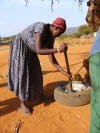
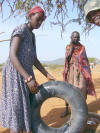

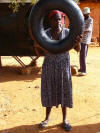
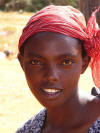
Anastasia Wangui, the girl who can repair tires
They all proceded in good teamwork to repair the tire. The most difficult part was to push the tire into the rim groove. They had no good tool for that, and the rim received some damage before it was done.
But Anastasia had the glue. She cut a piece out of the remains of another tube and glued and hammered it on.
It seems to me that she deserves some better clothes and, more importantly, some tools. The least would be a pressure gauge, but the best would be a tool to push the tire ring into the rim. The tools I know for that purpose are huge and cant be transported there easily, but Ill see what I can do. (I actually found a suitable tool later.)
Another hitch-hiker jumped into my car, Emily, a nursing student. She is Samburu and a fun-loving, outgoing, happy person who made the distance to Kisima pleasant. We chatted the whole time. I dont know why I seem to hit upon the nicest and most exotic girls of Kenya these days.
She owns 5 cows. And she is engaged, in this case also meaning that three cows have been given to her parents by the parents of her future husband. (It probably doesnt mean anything whether they were given to herself or to her parents, because in the Maasai and Samburu culture everything is owned by the parents anyway.) Being on her way to a good job certainly makes her more attractive on the marriage market.

Emily Naseku Lasangurikuri, nursing student and hitch-hiker
Actually two more hitch-hikers had jumped into the back, a man and a boy, both Samburu. But since they couldnt speak English, I had little contact with them.
I dropped her off in Kisima, then continued the still long way through Mugie, Churo, Tangulbei, and Loruk to Baringo. On the way the next tire went flat. Luckily I noticed it in spite of the very stony stretch of track, just before it was entirely flat, so I could avoid additional damage. I changed wheels again, can do that now very quickly indeed, and continued on.
I arrived in Baringo just past 15 oclock and was welcomed by a hot shower and soap, for which I am eternally grateful.
My hair is an excellent dust filter. It filters the Kenyan air. The amounts of dust it can collect are staggering.
Nearly everybody can repair tires around here, so one of the employees of my hosts immediately fixed that tire while I showered.
Permanent guests under the thatched roof of the houses of my hosts in Baringo are bats. They are not shy and fly across the room while we sit there.
As usual I worked with the computers of my hosts a little bit and fixed email problems. It is always frightening to see an Internet connection that requires several dial attempts and breaks down every few minutes. But there are plans to try a mobile phone connection, which is expected to be much more reliable.
In the afternoon I met Chemandazi, who happened to come to the RAE clinic that day.
She is a very happy child now. Please check the 2002 report for her story and dont miss the epilogue. Remember, after a bad snake bite she went from about to die to about to have her arm amputated, about to lose function of her hand, eventually to the best possible outcomeher arm looking near-normal after skin grafts, her hand fully functional. She also proved to be an unusual upcountry Pokot girl. She is very resilient, open, outgoing, even humorous, and intelligent.
In the morning I still worked a little bit on the computers. Then I slowly got going and drove off towards Nairobi shortly after noon.
I stopped at Ashas place and met her brother in law, who offered to lead me to Asha. She is now, in her profession as a policewoman, stationed at Marigat, not far from Baringo, more or less the next bigger town. We drove there, met Asha and her brother Joginder and chatted a while.
When I looked at my watch again, a lot of time had passed, and I drove off at around 14 oclock.
I stopped in Marigat once more, to take on fuel. It turned out that the Suzuki Maruti Sierra uses much less fuel than its smaller brother, the Suzuki Sierra. I measured the consumption at around 7 l per 100 km overall. Since my last drive contained places that were difficult and slow to drive, I estimate the actual consumption in 5th gear with a speed of 60-80 km/h as 5-6 l. Thats excellent. It translates into a range of over 500 km on one tank filling.
Seen on the way:

Bicycles as charcoal transport machines
A huge roadside poster advertises condoms. DJ Pinye is one of the best-known disk jockeys in Kenya.
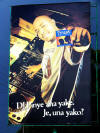
DJ Pinye has his. Do you have yours?
Not much to report and no photos. I went to Rasuls, had the jeep checked, and had a long discussion about off-road tires.
We even went to a tire dealer and discussed the thorn puncture with him. He recommended tubeless tires, but Im actually sure that wouldnt work for long, because the first time the tire has to be unmounted, the tire bead or the rim would be damaged and lose its airtightness. Apart from that he may well be right in saying that tubeless tires solve about half of the problem, because many thorns would still go in, but wouldnt necessarily let the air out, even if they poked through the inner surface.
First opportunity to be online again after about a week. Had to delete over 1,300 spam mails and could finally upload this page and the 2004 part to the Chemandazi epilogue.
I decided to drive west. Plans have changed, and the Amboseli schedule is again different. Im trying to meet some people there, and this makes sense only when they are actually there.
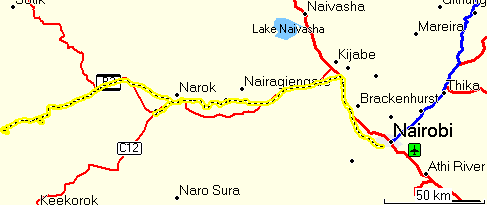
GPS track Narobi - Aitong
I also decided that I wanted to test a different route to Maasai Mara, a northern one via Aitong.
After I had already driven to the turnoff at the end of the paved road, I met a very competent policewoman who described the quality of the roads to me and recommended that I drive back and take the new paved road for as far as it takes me.
So I turned back and refilled the tank again with an additional 2 l of petrol. Then I set out again and drove along the excellent, fast, and new road through Ololunga, until I reached the turnoff to Ngorengore. That track was rather bad, so I could continue only very slowly.
I continued to Lemek, where I took up a hitchhiker, Joseph C. Serek, a Maasai on his way to his home town Aitong.
His knowledge of the area helped me quite a bit. We came to a piece of track where water was flowing across and along. We actually tried to continue, but about at the end of the visible part in the following photo a small lake had formed that was impossible to cross.
It was difficult to even turn the car around to head back, but I managed to do it, and we took a different route, crossing through quite difficult bush territory.
Eventually we made it across the bush country and reached Aitong, where I dropped Joseph at his home and continued on my way south.
Immediately beyond Aitong I encountered lots of wild animals. This is still Maasai country, but the wildlife penetrates that area, perhaps because lions dont dare to get too close to the Maasai.
To my surprise I even spotted a small herd of eland among the many other species.
As darkness fell, I zig-zagged into a very beautiful area with some trees and camped at the top of a small escarpment with a wonderful view over the area still in front of me.
In the morning I woke up at dusk and drove off. Only a few meters away from my camp site I immediately got stuck, because I had not seen how deep a ditch was, into which my left wheels had dipped. The car sat on its belly with the left rear wheel some 10 cm above the ground.
Since the little jeep doesnt have differential locks, one wheel in the air means more or less no traction at all. I tried to put stones under the hovering wheel and had to work only some 10 minutes to get the car rolling again. I first tried to move backwards, because the ditch continued forward and didnt immediately get better, but the slope was downhill, and I couldnt get the car to move backward against the force of gravity. So I took the risk and tried to move forward. It worked.
Then I continued south through an area teeming with wildlife, until I reached the grass savanna of the Serengeti landscape, of which Maasai Mara is an extension.
The grass was very high. Wild animals try to avoid such high grass, because predators are difficult to see. Indeed I didnt see any either.
After reaching Maasai Mara in the late morning, I turned west to see the river Mara. Maasai Mara is the area around the point where Talek River flows into the Mara. The two rivers cut Maasai Mara into three slices, of which I was now exploring the northeastern one. There are only two bridges across the river Mara in this area, but Talek can be crossed at various crossings and two bridges, one of which consists only of two narrow rails and leads directly into the lodge compound of the Mara Intrepids Lodge. The other is at Talek Gate, not far from the eastern end of Maasai Mara.
I reached the Mara at around noon.

View at Mara Serena Lodge from across the river



Crocodiles and hippos in the river Mara




Zebras crossing the river Mara



African buffalo; Thompsons gazelle; Baboon mother carrying her child

One of the green hills of Africa
In the evening I drove back to the area near Mara Intrepids Lodge, then I made camp again on a small hill. Unfortunately I ran out of drinking water that evening, so I decided to go into one of the lodges the next morning, not only to get water, but also to take a shower and change clothes, which had also become quite desirable after the second night out in the bush.

GPS track of game drives in Maasai Mara
I woke up at dusk again and drove out of my camping place.
I checked a few river crossings, particularly one near Intrepids Lodge, but even though I saw other vehicles crossing, I decided that the risk to get stuck was too high for my small jeep with its smaller tires and different, narrower track. So I headed east to cross Talek River at Talek Gate.
On the way I came across a small herd of Cokes Hartebeest, a somewhat rare relative of the more common topi. Among the hartebeests there were some Thompsons gazelles and a few Grants gazelles.
That route also entailed two crossings of tributaries of Talek, which both had enough water to scare me. But I very carefully watched a truck crossing those and decided that they were flat and smooth enough for me. Indeed I had no problems crossing them both.

Maasai children near Talek Gate
I entered the game reserve through Talek Gate and paid my dues for the day.
I then continued back to Intrepids on the south side of Talek and found, inspected, and took GPS waypoints for a few more possible crossings, all of them currently too risky to try due to high water.

Safari ants crossing the track
At one place I saw safari ants crossing my way. They create an ant freeway between two living walls of stationary ants that hold on to each other, and even outside the walls a considerable area is covered by ants protecting the freeway in the middle.
I wanted to inspect the relatively big airfield near Intrepids, that I had seen many times from surrounding hills, but never accurately positioned. The airfield, as well as the Intrepids lodge itself, lies between Talek River on the south and a major tributary to Talek that wraps around on the west and north side, so it is somewhat difficult to get to.
I crossed Talek River once more, this time via the small car bridge that consists only of two narrow, parallel rails and requires some precision to drive over. I did not know of the existence of that car bridge before. Perhaps it was only recently built.
Then I chatted with the people at Intrepids and obtained a copy of their price list. Their prices are relatively normal, somewhat higher than those of Fig Tree.
However, they also run an outlying camp named Explorers, where the current prices are $595 for a single and $800 for a double room (or tent, I didnt check that) per night. After inspecting, measuring, and registering the airfield, I paid a brief visit to Explorers.

View from the terrace of Explorers Lodge
I drove back to Intrepids, crossed Talek River one last time for today, and continued leisurely towards Fig Tree Tented Camp, one of my favorite lodges in Maasai Mara.
On the way I meandered along Talek River and drove into several narrow bush clearings. When I turned back in one of these to drive out again through the narrow passage, I noticed that there were several elephants that I had totally overlooked.

Female elephant, telling me gently not to come too close to her nearby baby
I waited patiently until they moved on, then drove out.
A similar thing happened again, when I did see a few elepants, but overlooked that there were several more on the other side of my route. Again the elephants quietly and slowly moved out of my way, but I backed out and turned back anyway, because I wasnt sure whether the track ahead was drivable at all.

Large numbers of zebra and wildebeest move to the river to drink
I checked into Fig Tree, chose one of their tents, which I greatly prefer over the huts, had a late lunch, rested a bit, then went out again for a short evening game drive.
Just after leaving the lodges parking place, I became witness to an actual hunt, something that is rare to observe. I saw a pair of silver-backed jackals eyeing a large herd of Thompsons gazelles, when one of them suddenly sprinted towards a gazelle baby and began chasing it.
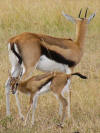
Thompsons gazelle baby with mother
The gazelle baby was probably lighter than the jackal, but had longer legs. It was incredibly fast and raced with big jumps across the grass savanna. The jackal tried for several minutes to outrun it, possibly hoping that it would turn back in a circle, so his mate could take over and chase it to exhaustion. But the gazelle did not do that. Instead it continued to run more or less in one direction.
I followed them across the savanna at high speed. Eventually the jackal had to give up. He had met his master in a young gazelle who had done everything right and survived. But anything less than perfect health and perfect behavior would have turned the little gazelle into jackal food.
In the evening sun I met a Cheetah mother with her three almost grown-up cubs, only one of which is visible in some of the photographs.




Cheetah mother with nearly adult cub
On the third photo the cheetah mother shows the yellow tag in her left ear, indicating that she is the subject of a research project.
Then the sun disappeared behind a thick cloud bank, so I returned to the lodge early and arranged for 20 l of petrol to be poured into the tank of my jeep. After a good dinner I sat down on the computer to write down the events of the last three days, then I enjoyed the sounds of the African night, the fresh and mosquito-free air flowing through the insect gauze windows, and slept well through the night.
This was a lion morning. Some photos from two morning game drives:
Lions lying low in the high grass are almost impossible to see, unless you are very close.
The mating season for the wildebeest is beginning, so the bulls stake out small temporary territories.
Returning to Fig Tree.


The entrance to Fig Tree Tented Camp and the footbridge across the Talek river
More game drives, but I now observe more and dont take as many photos. Particularly at dusk I saw several interesting animals, a small herd of Eland, all looking young to me, and a pair of bat-eared foxes. It was still too dark to take photos.
During the last few days I have seen a group of dwarf mongoose several times, but they can rarely be photographed, so you have to believe me. But some other morning photos follow.
For a while I observed a pair of silver-backed jackals in the early morning. For the first time I heard their call, presumably a territory call. To me it sounds exactly like a one-time high-pitched shout of a very excited or even fearful hyaena, another example for the many things in Africa that are not what they seem to be.
Then I saw a pride of lions, male, two females and a whole lot of cubs of two different ages. Unfortunately they walked into the high grass before I could take any good photographs, so I can show only these two quick shots.
I keep trying to document the abundance of wildlife and the large herds, but I find it difficult to capture this impression in a photograph. Nevertheless I keep trying.


Grants gazelle, topi, gnu, zebra; gnus congregating at Talek River for drinking
The following photos show what it can look like when a zebra gets attacked by a lion and manages to escape.


Zebra with typical lion wounds, left side; right side
This zebra may yet die because of infection with various microscopic and macroscopic parasites. The wounds look rather bad to me. But then these African animals are incredibly tough.
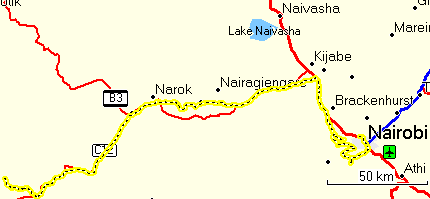
GPS track Maasai Mara Nairobi
I got up at 5:15 and drove out at 5:30 oclock. Sunrise is just after 6:30, so it was still totally dark when I slowly rolled from the lodge into the wilderness.
I saw many animals in the headlights, first herds of gnus, then bat-eared foxes, then a lioness, stalking along the edge of the high grass next to the car track. Too dark to take photos, of course, so I passed her and went on, only to meet another one, perhaps a bit too far to belong to the same pride, but I cant be sure.
A few kilometers on I saw another two lions, a beautiful couple, male and female, next to the track. When I turned the car towards them to see them better in the headlight beam, they slowly turned away and walked out into the dark space.
The next obstacles were two huge elephant bulls, slowly walking in my direction on my intended track. I followed them slowly until they eventually decided to take a different direction.
By that time the first blue glimmer of dusk had become visible in the east. I continued on my way, being led by the illuminated GPS screen, and had to depart from my route twice because of water, i.e. little ponds on the track that were too risky or outright impossible to cross.
The sun rose in the typical bright yellow of a relatively clean atmosphere, something we no longer have in the industrialized countries, and I reached the main track towards Narok. On my way I passed a tiny roadside settlement whose surroundings were littered by pieces of plastic bags. This, I guess, is one of the downsides of the new consumerism when the public services like garbage collection cannot be established at the same time.
I met two Maasai schoolchildren in their school uniforms and took a photo.
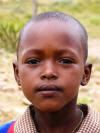
Maasai girl (in school uniform)
It makes me happy when I see these kids go to school. By far not all of them have that privilege.
The road between Narok and Ntulelei has been, or is still being repaired. I met the repair truck on the way. Funny, the same thing has happened to me before. They always seem to repair that stretch in June, then the repairs hold for half a year. Ntulelei itself and the distance to the edge of the rift valley is as terrible as it was, however, so that took me some time.
Near the satellite station down in the Rift Valley I took a hitch-hiker, a middle-aged woman who had to leave her daughter behind because I only have one seat in the car. She immediately asked me for KSh100 to give to her daughter, with the promise that I would get it back on arrival. The story seemed to be that she first had to pick up the money at her destination, which, of course, doesnt make sense, because without money she wouldnt have been able to pay the matatu (minibus), had she not met me. But the thought of somehow getting money from wazungu (European-looking foreigners) is so deeply ingrained in many people here that she just had to do this. I hesitated at first, but then I gave her the KSh100 out of curiosity how this would develop later.
She continued to tell me a story about her mother who had allegedly lost both legs, so she urgently needed my help with more money. But after a while, as we chatted (and she noticed that I knew the country a little better), we developed a much friendlier, more even-handed relationship, and I guess she regretted the money spin.
I took her to the place she wanted, even going slightly out of my way, and asked her for the KSh100. She reached for her handbag and wanted to give them back, so I can perhaps assume that the money thing is just a superficial idea that has made the rounds in Kenya. Perhaps as a Kenyan youre looked at askance when you tell somebody youve met a mzungu (now guess the meaningyes, its the singular of wazungu in Kiswahili) and havent wrenched some money out of him.
I reached Langata Link in the early afternoon, uploaded the current version of this story, then continued to friends in Nairobi, where I stayed for the night.
Driving through Nairobi at that time of the day is very slow due to the permanent traffic jam. I used the time to chat with a friend whom I was taking to Nairobi city who works for the Amboseli Trust for Elephants. And I took some photos of people selling things to the captive audience in the cars.
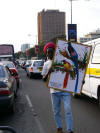

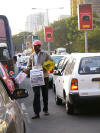
Street sellers on Uhuru Highway
This morning I first heard the entire story of the matatu (minibus) revolution that happened earlier this year, and Im trying to retell it here.
Though nearly everybody uses a matatu in Kenya sometimes, and the whole economy depends on this efficient means of transport, they still had a bad reputation and indeed a high number of accidents, particularly also fatal ones, so the relationship between the matatus and the population as a whole was a mixture of love and hate.
So the new government decided to do something about the accidents, and these measures were hugely popular. Starting on February 1st, all matatus had to have a yellow stripe marking, seat belts for all passengers that actually have to be worn, a limitation of 14 passengers for the standard Nissan (or similar) minibus, and speed governors, automatically limiting their speed to 80 km/h. They also had to follow pre-announced routes and schedules to make them more reliable for passengers who depended on them, mostly to get to work.
The matatu organization tried to resist these changes, and indeed on that first of February only few matatus were actually modified according to the new rules. But the government insisted, and the police indeed stopped the now illegal old style matatus. By the way, this allowed the few compliant ones to demand exorbitant prices during the first days after the change.
To cut the long story short, the government won this battle decisively. All matatus now comply with the new rules, and indeed the accidents, particularly the fatalities, have been reduced convincingly. Prices have, as expected, risen somewhat, but overall this was a very big popularity stunt of the new government and a commendable improvement of road security. One young Kenyan told me he now gladly uses matatus, whereas he had tried to avoid them out of fear of accidents before the change.
This time I had to drive right across Nairobi several times, and so there were a few opportunities to take some photos showing the signs of a new consumer society.
These photos were taken in difficult circumstances. I had no driver, and it is truly difficult to drive in Nairobi while at the same time taking photos, avoiding accidents, and trying to prevent attacks by certain malevolent people. I apologise for the low quality of these photos.





More street sellers, this time in Westlands
The following photos show advertising signs, mostly along Uhuru Highway.
Advertising is in a way very truthful, not necessarily regarding the advertised products properties, but fairly precisely regarding the wishes and dreams of the recipients.
Note the Adopt a Light campaign. It appears that advertising is actually paying for street lightingan interesting concept.


Public service bus; private matatu
The matatus now always show the newly legally required yellow stripe with the route on it, sometimes also the route numbers and the maximum number of passengers, usually 14 for the standard minibus.
Gone are the times of the decrepit city busesthe new ones look decidedly more elegant and are probably more comfortable as well. Everybody who has observed Kenya over the last decades sees the progress.
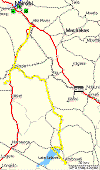
GPS track (first part Nairobi Athi River missing)
This time I tried to document the driving part a little bit and take at least one photo every hour or two. The trip begins on the paved roads, first the Mombasa Road out of Nairobi, then the road from Athi River to Namanga, on which the following photo was taken.

The road to Kajiado and Namanga
On the way I visited friends who were building a new, absolutely unique house when I last saw them. This time the house was finished, and I could take some photos.
The house is built on a hillside and overlooks the vast African landscape.
Very unique is the toilet, even from it you can overlook the landscape. Obviously out there in the bush you dont have a sewerage system, so the toilets are of a different design.



Some photos showing the inside of the house

Photo on the wall by a famous photographer
Jonathan Kingdon is one of the very well known authors on African biology, particularly zoology. One of his books that I revere is, Island Africa, referring not to an island in the water, but to biological islands on mountains that were once connected by lowland bridges when the climate was different.
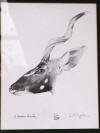
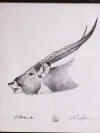
Two sketches by Jonathan Kingdon
The road south turns off from Kajiado. We would call it a track, but the local designation is still road or, more precisely, gravel road or, in Kenyan parlance, murram road.
This one was rather rough up to Imaroro, but then it improved such that I could drive the entire stretch through Mashuru to Osilalei at 50-60 km/h.
On my way I saw something that at first looked like a ruin to me. But this appearance was only due to the irregular window structure. In fact this was a primary school, not working on a Saturday.
As I walked around taking photos, a man appeared, who turned out to be the head teacher. He was very friendly, and we chatted for a short while.

The road from Mashuru to Osilalei
One of the many unusual professions in Kenya is that of the travelling preacher. They usually come in two, one preaching in Kiswahili, the other repeating every sentence in English, yielding a very captivating, continuous speech.


Osilalei; travelling preachers


Crossing the dry river Selengei; through the bush savanna
Past Lenkisim mission I met a donkey caravan, driven by two Maasai schoolgirls around 11 years of age. I chatted with the older one and found her to be mentally surprising ripe for her age. I probably couldnt chat like that with an 11-year-old back home. She spoke English well, was very self-confident, actually drove the conversation and occasionally sounded like an adult, while still joking and laughing. She asked me where I came from and actually knew a bit about Germany. It is encouraging to see at least some children out there getting a school education. They didnt let themselves being photographed though. I could have offered them money for taking photos, but in my experience they then pose like stone sculptures and look very unnatural.

Two girls driving a donkey caravan carrying water
On the last bit of my tour my path was blocked while I was driving on a route that I had used several times before. Water had washed out deep gulleys. At one point I had a meter-deep gulley to my left and one to my right, cutting through my track, and in front of me the two united, forcing me to turn back.
![]()
GPS track, getting around the new gulleys
It took me a while and two friendly and helpful Maasai boys to find a new way to Meshenani Gate, but this took so much time that I was running out of daylight and could no longer stop to take photographs. I even passed a lioness with her cubs without stopping.
I have meanwhile adjusted the GPS waypoints and route accordingly, but I could imagine that those gulleys keep growing, forcing me to recommend a slight detour around the other side of that range of small hills. That route would actually be simpler, but also a bit longer and a bit less interesting.
I arrived at the camp site when it was already almost dark and was received with a hot shower and a nice dinner.
First I worked a bit on two computers, fixed the non-functional networking, etc., then drove around Amboseli to see how the place has changed.
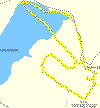
GPS track game drives Amboseli
This years rains have been sparse. At this time there is still some green, but foreseeably there will be a hardship for many animals around September, when it will be really dry.




Some Kilimanjaro pictures as the sun sets: car; Maasai; elephant bull; wildebeest
One species of bird, the nightjar, likes to sit in the sand at night and fly up only just before you step on him. I think the German name is Ziegenmelker.

Nightjar, a nocturnal insectivorous bird
During the night I woke up a few times because animals came close to the tent, but none of them ate me. One of them that stayed near my tent was one of the two buffalos that live around the camp.
Just when I was about to get up and leave, the buffalo walked past me so close that I preferred to stop breathing and be very quiet. The tent has large insect gauze windows and doors. Only on the back side, where my jeep was parked, the flaps were let down, on the other three sides they were open. My head was about 1 m from the window, and the buffalo walked past another 1 m from the tent, so I didnt miss any details, not even the cow-like smell. Then he stopped and began grazing. So I couldnt get up now.
The buffalo slowly walked away from the tent, always grazing, but he never went far enough for me to feel entirely secure. But time was passing, so I got up inside the tent, moved about and made some noise. Both buffalos were now standing perhaps 15 m from the tent.
When this was not enough to make them move away, I opened the tent entrance zipper and stepped outside, directly facing the two buffalos. They once chased one of the Maasai watchmen around the water tank trailer, so I was a bit wary of being attacked, but I calculated that in a situation like this the buffalo would have to be insane to attack.
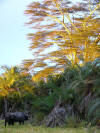
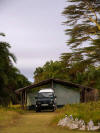
Buffalos behind the tent; tent with jeep
So I began to move sideways, making some noise and staring at the buffalos. They still stayed there for a while, then the fact that they could no longer graze in a situation like this apparently got on their nerves enough to make them move. They turned away and slowly walked off. So now I can claim that I have stared down a wild buffalo.
At this time the watchman and the cook had already appeared as well, so I could now have a little breakfast, rather than driving out in the dark.
After the chai and a peanut butter toast I jumped into the jeep and drove out. It was a cool, overcast day, ideal for travelling. On my way I met a hyaena family, then a pack of hyaenas on a morning patrol run, later vultures on an already completely eaten kill.



Hyeana mother licking her child; hyaenas on patrol; vultures
Then I passed by a hippo that behaved unusually in that it kept grazing in daylight, while his companions had already retreated into the safety of the water in the swamp. No surprise this one has already lost his tail. But it allowed me to take a photo and even a video.

Hippo
Video
I turned toward northeast to leave Amboseli and drove right across the dry Lake Amboseli, when I met a large group of elephants walking briskly towards the swamp.
I stayed with them for a short while, taking photos, then I continued along the straight racetrack across the dry lake bed. I passed Meshenani Gate, then continued along the gravel road to Namanga, the fastest way back.
This road had recently been graded, and I had already heard of its good quality. Indeed this road was nothing short of amazing. It was made of sand and stones, but the surface was so perfect that, as I increased the speed to 70 km/h, the shaking and rumbling was reduced to only a slight vibration and a soft rumbling. At 70 apparently the tires absorb most of the stony unevenness, and the jeep glides along almost like on a paved road. This is certainly the best gravel road I have ever experienced.


The road from Amboseli to Namanga; the two herding boys
Except for the last bit from Namanga airfield to Namanga town the road remained as good, so the time needed is now much less than it used to be. I wonder how long it will take until the road decays.
I drove through Namanga, then along the paved road through some small towns, some of which had roadside markets like this.
The first mobile phone transmitter seems to be in Ilbisil. Through Kajiado and Athi River I drove onto the Mombasa Road, where heavy and slow truck traffic slowed me down, so it took about three quarters of an hour to cover the mere 26 km to Nairobi. I still had to cross Nairobi, then moved into a private house of a friend for my last night before departure.
During the morning and early afternoon I enjoyed the hospitality and the chats about various topics, then I had to get ready to leave. I drove to the Rasuls Car Hire & Tours shop, returned the jeep and was taken to the airport, but not before being invited to a Chinese dinner in the new shopping mall that houses the new Hyper Uchumi supermarket next to the Mombasa Road.
The new mall is quite spectacular. It houses a whole range of fast food Restaurants, Indian and Chinese among them. I was invited to a Chinese dinner, which I enjoyed very much.
Unfortunately my departure time drew nearer, so I was driven to the airport, where I went through the slow departure procedures. These days they can easily take 2 hours, so it is advisable to be at the airport some 2, better 3 hours before departure.
I ended up in the British Airways jumbo jet and recorded the long night flight home via London Heathrow on the GPS.
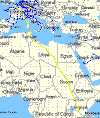
GPS track Nairobi London Heathrow Munich
In the middle of the night I woke up and saw brightly lit cities along the shore of the Mediterranean. A glance on the GPS showed that the plane was flying a far westerly route along the Libyan and Tunesian coast, probably to minimize head wind delay. We were also flying slightly lower than usual, likely for the same reason. After changing planes at Heathrow I finally reached home.

The Munich airport from the air
If in this text you find any typos, orthographic errors (even small ones), ungrammatical sentences, wrong or illogical information (like wrong names of birds), if you want me to write more details about something in particular, or if you want one of the photos in full resolution (usually 1,600 x 1,200 pixels), please click on the email sign below and write to me. Many thanks!
Copyright 2004-2023 Hans-Georg Michna.
Private homepage – Hans-Georg Michna
Kenya travel reports: 1999, 2000, 2002, 2003, 2004, 2005, 2006, 2007, 2008, 2009, 2010, 2011, 2012, 2013-Goma, 2013, 2014, 2015, 2016, 2017, 2018, 2019
Kenya Safari Travel Plan, Kenya 1980-2000 photos
hits since 2007-11-01
Free PHP scripts by PHPJunkYard.com